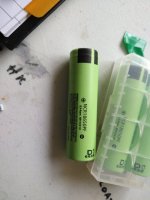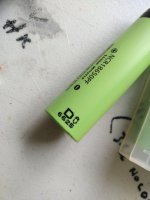johnnyz
1 kW
Hi everyone
I have a question on a large order of cells I got from NKON. They are the Panasonic NCR18650PF cells..
Heres a pic of them..


I tested about 5 of them and they all came in at about 2580 using my Imax charger . (Charged to full and then discharged to 3 volts at 1 amp. )
Obviously this is less than their rated capacity although the Imax wont go down to 2.75 volts.
Question...are these grade D cells and if so what is the difference between Grade A cells and these. I am also wondering why this is not advertised at NKON before one buys large quantities.
Thanks
John
I have a question on a large order of cells I got from NKON. They are the Panasonic NCR18650PF cells..
Heres a pic of them..


I tested about 5 of them and they all came in at about 2580 using my Imax charger . (Charged to full and then discharged to 3 volts at 1 amp. )
Obviously this is less than their rated capacity although the Imax wont go down to 2.75 volts.
Question...are these grade D cells and if so what is the difference between Grade A cells and these. I am also wondering why this is not advertised at NKON before one buys large quantities.
Thanks
John

